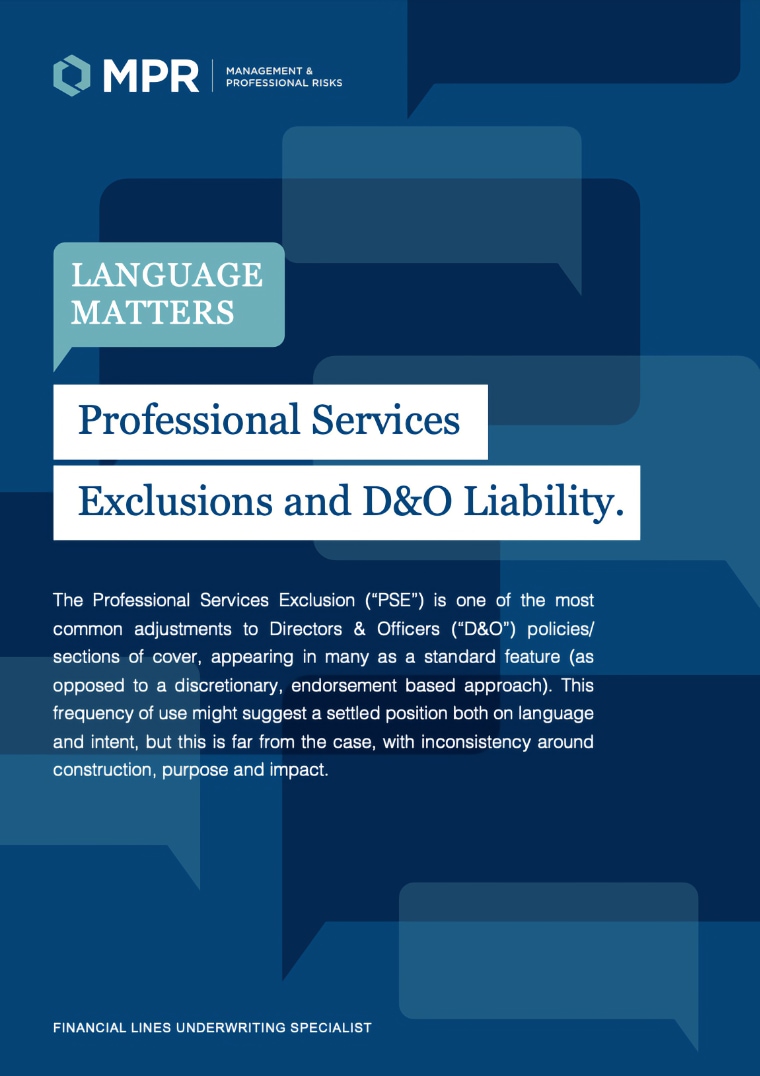The Professional Services Exclusion (“PSE”) is one of the most common adjustments to Directors & Officers (“D&O”) policies/sections of cover, appearing in many as a standard feature (as opposed to a discretionary, endorsement based approach). This frequency of use might suggest a settled position both on language and intent, but this is far from the case, with inconsistency around construction, purpose and impact.
Notwithstanding this context, two factors are relatively clear:
- examples of personal liability for professional negligence are rare. In a professional services claim, a claimant normally takes a rational approach and sues the organisation, rather than the insured person (‘IP’) him/herself. This makes sense, because it is the organisation that the IP works for that contracted with the claimant, and if negligent professional advice causes loss, the employer organisation is vicariously liable for the acts of employees; and
- there is a scarcity of case law in the UK, so no obvious signposts even on a general level, let alone on the subtleties of D&O exclusionary language.
Decisions on personal liability on Professional Indemnity (“PI”) policies are rare but can be instructive. Merrett v Babb (2001) potentially opened the way, attaching liability to an individual for a mortgage valuation. However, that case was decided with very particular public policy considerations in mind and it was recognised that under normal circumstances the claim should be against the employer, who would have professional indemnity insurance in place to manage the claim (in this case the employer had gone out of business and no longer carried insurance). It was considered that, to fix a personal duty of care, there would (again, generally) have to be an assumption of personal responsibility to indemnify the claimant against the risk of loss. Even if there had been any such assumption, a claimant would still have needed to reasonably rely on that assumption in order to crystallise any such personal duty. More recent examples have developed in favour of the individual professional. In Mavis Russell v (1) Walker & Co (2) Robert Chisnall & Others (also a surveyor case) the court did not agree that Mr Chisnall had done enough to assume a personal liability and so Mrs Russell’s claim was unsuccessful (the employer was also insolvent in this case). This decision followed Matthews v Ashdown Lyons and Maldoom where, even though the value of the property involved was £750,000 and could not be considered ‘modest’ (as was the case in Merrett v Babb), the court said that, to impose a personal duty of care on the individual would have been to ignore the separate legal identity of the employer.
Even if the claimant doesn’t follow the normal route and chooses to sue the IP and/or his/her employer, if the IP’s actions are not fraudulent, his/her defence should be relatively straightforward i.e. the employer is the respondent. If those costs are (for whatever reason) not indemnified by his/her company, the D&O policy would not intervene. The purpose of the PSE is to clarify that where the policyholder should, or does, buy PI insurance, any residual doubt is removed and a brighter dividing line created. Even without the PSE, other practical difficulties remain e.g. in addition to what has already been said, to trigger a D&O policy, acts must be in an ‘Insured Capacity’, as opposed to the capacity as a ‘professional’.
As always, danger lurks in the language that is used. The meaning of ‘professional’ varies according to the context in which it is set, but it generally connotes ‘pertaining or appropriate to a learned and traditional profession’. It is therefore normal to see a PSE on a D&O policy for a trade or profession where PI cover ought be in place and would typically be purchased. However unlikely it is that a claim could find a way to the policy, it avoids any doubt. The real difficulty comes where the language is so generic and poorly constructed that the application of the PSE may extend beyond what one might reasonably contemplate as professional services for a fee i.e. within the province of a PI policy. An example of PSE language might read:
“any liability for, or directly or indirectly arising out of, or in any way connected with the giving of professional advice or service whether or not for remuneration or any act, error or omission relating thereto.”
To exclude ‘service’, as is often the case, creates further ambiguity. So, if you’re a director of a residential block, are you are providing a ‘service’ to the other residents? Probably. Will a transport firm be delivering a bus or haulage ‘service’ to clients? Also probably. This is why the construction of the PSE is so important and should be as precise as possible, so as to minimise the potential for a wider interpretation and subsequent dispute.
One of the main purposes of the PSE is as a ‘don’t come looking for cover here’ signpost, deterring creative lawyers from trying to find a home for a stray PI claim. Whatever the view, the construction of the PSE is vital and, in broad terms, it seeks to create a line of demarcation between D&O and PI insurance. However, and as is most always often the case, the language matters.


